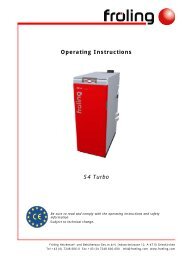Operating Instructions TURBOMAT TM 150 / 220 - Econergy Ltd
Operating Instructions TURBOMAT TM 150 / 220 - Econergy Ltd
Operating Instructions TURBOMAT TM 150 / 220 - Econergy Ltd
Create successful ePaper yourself
Turn your PDF publications into a flip-book with our unique Google optimized e-Paper software.
Maintenance and cleaning:<br />
- Remove the separating plates (Pos5) and remove the accumulated soot deposits with the ash<br />
scraper.<br />
Also clean the boiler's inner walls.<br />
- Check the firebrick for damage (Pos6)<br />
Open the combustion chamber door and perform a simple visual check of the combustion<br />
chamber (small fissures or a rough surface are normal)<br />
- Check the grate; to see whether the grate elements have shifted (Pos7)<br />
Open the combustion chamber door and perform a simple visual check<br />
- Blow out any obstructions in the over-pressure monitor (Pos11)<br />
On the <strong>TM</strong> <strong>150</strong>, also blow out the under-pressure measuring port with air (Pos12)<br />
(CAUTION: Do not blow air into the differential pressure measuring transducer)<br />
- Check the gearbox for a good seal (Pos10)<br />
Important: As the system operator, you are legally obligated to have the thermal discharge safety<br />
device operationally checked annually by a specialist.<br />
- Thermal discharge safety device<br />
Press the test button - water must flow into the discharge funnel. After releasing the button,<br />
the funnel must seal again. If the amount of discharged water was very low, the thermal<br />
discharge safety device or the safety battery is calcified and must be flushed out with a deliming<br />
agent (thinned formic acid, for example). If the amount continues to decrease, the<br />
seals and the valve set must be cleaned.<br />
- Safety valve<br />
The safety valves have a test button. Press the test button. If the valve is operating correctly,<br />
water comes out. After the test button is released, the valve must re-seal!<br />
- Expansion Tank<br />
There is a test valve on each expansion tank (similar to the valve on a vehicle tire), which<br />
can be briefly actuated (pressed in). If water comes out, the expansion tank is defective. If<br />
nitrogen (anti-corrosion protection) comes out, everything is okay. However, to see clear<br />
evidence of the system's operability, the water pressure in the heating system must first be<br />
lowered to 0 bar.<br />
Have it checked by a specialist if necessary<br />
- Soundness of door seals<br />
By actuating the door, you can check to see whether it still closes tightly (by drawing shut).<br />
Next, check the ceramic fibre seal, to see whether it is still properly aligned on the door<br />
frame (by the imprint in the ceramic fibre cord). If not properly aligned, this will be evidenced<br />
by a black discoloration or a break in the imprint. If the soundness of the seal is no longer<br />
assured, the door latches must be re-tightened or the seal must be replaced.<br />
- Check the chimney and the connection line to the chimney<br />
The chimney should be regularly serviced (by a chimney sweep). After the chimney is<br />
cleaned, it is imperative to also have the connection line from the boiler to the chimney<br />
checked for sediments (for example due to chimney cleaning)<br />
- Check explosion flap and/or draught controller flap<br />
Check the explosion flap (and the draught controller too, if there is one) for ease of<br />
operation.<br />
14 B0310003 Edition 2003



